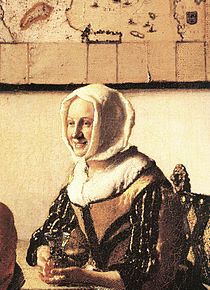Officer and Laughing Girl
| Officer and Laughing Girl | |
|---|---|
 |
|
| Artist | Johannes Vermeer |
| Year | c. 1657 |
| Medium | Oil on canvas |
| Dimensions | 50.48 cm × 46.04 cm (19.87 in × 18.13 in) |
| Location | The Frick Collection, New York |
 |
|
|
1 min. 48 sec. |
Officer and Laughing Girl, also known as Officer and a Laughing Girl, Officer With a Laughing Girl or De Soldaat en het Lachende Meisje, was painted by the Dutch artist Johannes Vermeer between 1655 and 1660. It was painted in oil on canvas, typical of most Dutch artists of the time, and is 50.5 by 46 cm. It now resides in The Frick Collection in New York.
Officer and Laughing Girl includes many of the characteristics of Vermeer's style. The main subject is a woman in a yellow dress, light is coming from the left hand side of the painting from an open window, and there is a large map on the wall. Each of these elements occur in some of his other paintings, although this painting differs slightly with the man also sitting at the table. Art historians, who have suggested conflicting interpretations of the work, believe that a painting by Gerard van Honthorst inspired the composition, and that Vermeer used a camera obscura to create the perspective in this painting.
The main subject is the woman, and soft, direct light falls on her face. She resembles Vermeer's wife, Catharina Bolnes, who is believed to have posed for many of his paintings. With x-ray photographs, art historians can see that Vermeer had planned to paint the woman with a large white collar which would have hid much of her yellow dress. Also, her cap was later extended to cover all of her hair, in order to draw attention to her face and expression. This yellow bodice with braiding has appeared in many of Vermeer's other portraits. It is called a schort and was usually worn as an everyday, common dress. The woman is also wearing a blue apron over her dress, but it is hidden in the shadows caused by the table. Blue aprons were common attire at that time because they hid stains well. Art historians have interpreted this to mean that the soldier surprised the girl with an impromptu visit during her morning chores. The woman is holding a wine glass, usually used for white wine. Because at that time, wine cost more than beer, it illustrates her wealth.
The man in the painting is a cavalier wearing a red coat and an expensive hat, showing his wealth and rank. His hat is wide- brimmed and made of beaver pelt, which was weather resistant and good for snowy and rainy conditions. The pelts for these hats were imported from the New World. This hat was probably from New Netherlands, which was then under the Dutch West India Company's control. The red in his uniform is associated with power and passion, bringing a passionate and emotional mood to the painting. His rank as an officer is identified by the black sash he wears. However, his presence in the immediate foreground is what the viewers notice first. His striking presence adds drama and mystery to the mood of the composition. This artistic device—in which an object is placed in the foreground to increase the depth of field of the overall painting—is called repoussoir. Caravaggio often used this technique and Vermeer probably learned it from a Caravaggist's painting.
...
Wikipedia
